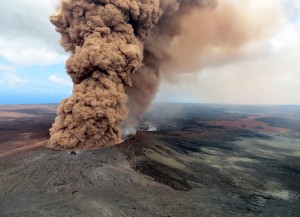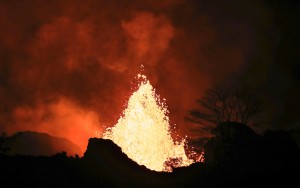Kilauea Heats Up Hawaii
May 30, 2018
Earlier this month, on May 3, Kilauea, a large volcano on the “Big Island” of Hawaii, erupted violently and pumped dangerous lava flows near residential neighborhoods, prompting local officials to order emergency evacuations. Since then, dozens of fissures have opened up along the slopes of the volcano, oozing glowing lava or shooting fountains of it high into the air. The volcano has also produced massive columns of smoke and ash and a haze with varying amounts of poisonous gases. As of today, Kilauea’s eruption proceeds without any signs of stopping, and new lava fissures and cracks appear daily.

A massive column of ash and smoke billows from Hawaii’s Kilauea volcano on May 4, 2018, near Pahoa, Hawaii. Credit: U.S. Geological Survey
Volcanologists have used flying drones to monitor Kilauea’s flowing lava as it creeps towards homes and other buildings in the Leilani Estates neighborhood near the town of Pahoa. Hawaii Governor David Ige mobilized the Hawaii National Guard to assist with evacuations and security in the area. So far, 82 homes have been destroyed by lava and around 2,000 residents have been evacuated. Kilauea’s flows have also damaged several other structures, including the Puna Geothermal Venture, a conversion plant that uses heat from volcanic activity to generate electric power.

Lava erupts from a fissure in the Kilauea volcano on May 22, 2018, in Kapoho, Hawaii. Credit: © Mario Tama, Getty Images
Kilauea is one of the world’s most active volcanoes. The current eruption is only the latest of a highly active eruption cycle that began in January 1983. This month’s eruption was preceded by a swarm of small earthquakes caused by the movement of magma beneath Kilauea and the collapse of a volcanic vent in Kilauae’s crater floor. On May 3, 2018, hours after a magnitude-5.0 earthquake, steam and lava spewed from several surface cracks on the eastern side of Hawaii’s Big Island.
Kilauea rises 4,190 feet (1,227 meters) above sea level and constitutes about 14 percent of the land area of the Big Island. Kilauea and massive Mauna Loa are the stars of the area’s Hawaii Volcanoes National Park. Kilauea is a shield volcano, a volcanic mountain with broad, gently sloping sides. Shield volcanoes commonly erupt in fountains of lava. The fountains feed lava lakes within a caldera (large crater), and long, often slow-moving flows seep down the volcano’s sides. Repeated eruptions produce layer upon layer of flows. The layers gradually build the slope upwards and outward, forming a shallow, rounded cone. The name shield volcano refers to such a volcano’s broadly curved shape, which resembles a soldier’s shield. Kilauea’s summit caldera contains a lava lake known as Halema`uma`u. In Hawaiian mythology, the molten lake is the home of the volcano goddess, Pele.
Volcanologists are worried about the many fissures that have opened along the eastern slope of Kilauea, spewing lava, smoke, and ash. Some flows reached the Pacific Ocean, where red-hot lava created huge clouds of steam laced with poisonous and stinky sulfur dioxide. Gases from Kilauea have collected into a toxic volcanic smog that has now drifted as far away as Guam and the Mariana Islands, where residents have been warned to limit outdoor activity.


